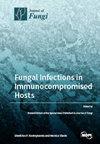LaeA 和天鹅绒蛋白参与调控霉菌毒素和其他真菌次生代谢物的产生
IF 4.2
2区 生物学
Q2 MICROBIOLOGY
引用次数: 0
摘要
真菌是具有农用化学品、医药和食品重要性的次生代谢物的丰富来源,如霉菌毒素、抗生素和抗肿瘤剂。次生代谢物在真菌的致病机理、生长发育、氧化状态调节以及适应/抵抗各种环境压力等方面发挥着重要作用。LaeA 含有一个 S-腺苷蛋氨酸结合位点,具有甲基转移酶活性。天鹅绒蛋白的成员包括 VeA、VelB、VelC、VelD 和 VosA,每个成员都有一个天鹅绒结构域。LaeA 和天鹅绒蛋白可形成多聚复合物,如 VosA-VelB 和 VelB-VeA-LaeA。它们属于全局调节因子,主要受光的影响。它们最重要的功能之一是调节负责次生代谢物生物合成的基因表达。本微型综述旨在介绍 LaeA 和天鹅绒蛋白对霉菌毒素和其他真菌次生代谢物生物合成调控的最新认知。在大多数情况下,LaeA 和绒毛蛋白对真菌次生代谢物的产生具有正向调节作用。受调控的真菌种类主要属于可产生霉菌毒素的致毒真菌,包括Alternaria、Aspergillus、Botrytis、Fusarium、Magnaporthe、Monascus和Penicillium属。我们可以通过全面调节真菌中的 LaeA 蛋白和绒毛蛋白来控制次生代谢物的产生,从而抑制有害霉菌毒素的产生,同时促进有用代谢物的产生。此外,LaeA 和天鹅绒蛋白的调控应该是激活真菌中沉默的生物合成基因簇(BGCs)以获得之前未被发现的代谢物的一种实用策略。本文章由计算机程序翻译,如有差异,请以英文原文为准。
Involvement of LaeA and Velvet Proteins in Regulating the Production of Mycotoxins and Other Fungal Secondary Metabolites
Fungi are rich sources of secondary metabolites of agrochemical, pharmaceutical, and food importance, such as mycotoxins, antibiotics, and antitumor agents. Secondary metabolites play vital roles in fungal pathogenesis, growth and development, oxidative status modulation, and adaptation/resistance to various environmental stresses. LaeA contains an S-adenosylmethionine binding site and displays methyltransferase activity. The members of velvet proteins include VeA, VelB, VelC, VelD and VosA for each member with a velvet domain. LaeA and velvet proteins can form multimeric complexes such as VosA-VelB and VelB-VeA-LaeA. They belong to global regulators and are mainly impacted by light. One of their most important functions is to regulate gene expressions that are responsible for secondary metabolite biosynthesis. The aim of this mini-review is to represent the newest cognition of the biosynthetic regulation of mycotoxins and other fungal secondary metabolites by LaeA and velvet proteins. In most cases, LaeA and velvet proteins positively regulate production of fungal secondary metabolites. The regulated fungal species mainly belong to the toxigenic fungi from the genera of Alternaria, Aspergillus, Botrytis, Fusarium, Magnaporthe, Monascus, and Penicillium for the production of mycotoxins. We can control secondary metabolite production to inhibit the production of harmful mycotoxins while promoting the production of useful metabolites by global regulation of LaeA and velvet proteins in fungi. Furthermore, the regulation by LaeA and velvet proteins should be a practical strategy in activating silent biosynthetic gene clusters (BGCs) in fungi to obtain previously undiscovered metabolites.
求助全文
通过发布文献求助,成功后即可免费获取论文全文。
去求助
来源期刊

Journal of Fungi
Medicine-Microbiology (medical)
CiteScore
6.70
自引率
14.90%
发文量
1151
审稿时长
11 weeks
期刊介绍:
Journal of Fungi (ISSN 2309-608X) is an international, peer-reviewed scientific open access journal that provides an advanced forum for studies related to pathogenic fungi, fungal biology, and all other aspects of fungal research. The journal publishes reviews, regular research papers, and communications in quarterly issues. Our aim is to encourage scientists to publish their experimental and theoretical results in as much detail as possible. Therefore, there is no restriction on paper length. Full experimental details must be provided so that the results can be reproduced.
 求助内容:
求助内容: 应助结果提醒方式:
应助结果提醒方式:


